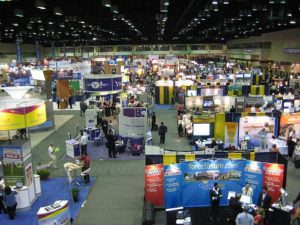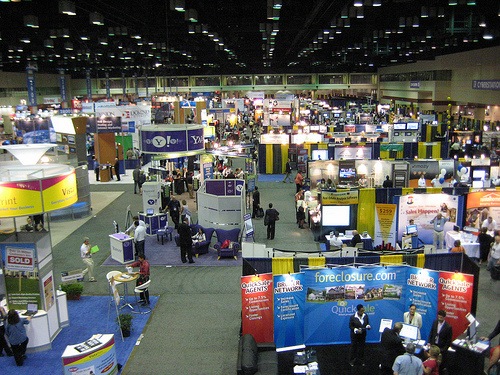 Wide-format printing is an excellent way to stand out in today’s crowded marketing environment at trade shows and other events. We like to say that large format printing technology makes “your big ideas even bigger.” When you couple the medium with a compelling graphic and prime location, using large format printing technology for trade show booth graphics and other special events grabs the attention of your intended audience.
Wide-format printing is an excellent way to stand out in today’s crowded marketing environment at trade shows and other events. We like to say that large format printing technology makes “your big ideas even bigger.” When you couple the medium with a compelling graphic and prime location, using large format printing technology for trade show booth graphics and other special events grabs the attention of your intended audience.
Before designing trade show booth graphics for large format printing technology, you should have an idea of the type of material on which you will print. These materials are referred to as “substrates”. From plastic to wood, vinyl to fabric, you have many options for large format printed project substrates for use in trade show displays or special events.
So, the real question is, how do you choose the right one for your project? We have a few ideas, which are outlined in Printing Impressions Magazine. We encourage you to start by asking yourself the following questions:
What is your budget?
As you can imagine, along with the different options for substrate materials, there are many different price points. Knowing what you have to spend on the project is an excellent place to help you narrow down your options. As PI World.com says, if your budget is on the lower side, go for paper, coroplast board, falcon board, or a scrim banner. Have a little more to spend? Consider acrylic, Dibond with a metallic finish or black PVC board with white ink. Defining what you can afford is always an excellent first step.
Where are you going to use the material?
Your placement and the related environment will have an enormous influence on the type of substrate you choose. We recommend different materials based on whether the final project will live indoors or outdoors, in a temperature-controlled environment or one subject to a varying condition. For instance, if it will be exposed to direct sunlight. However, it should be noted that most (if not all) outdoor substrates can be used indoors; it’s when you want to put a substrate more suited to an indoor environment outdoors that you start to have issues.
The excellent news that PI World notes is there are many different price points for all budgets in materials available, no matter whether the project will be indoors or outdoors.
How long do you need this project to be in use?
The implications here are that some materials are more durable than others. The longer you need the project to last, the more significant the investment should be in the substrate to accommodate those needs.
Now that you have answered these questions, you can begin sorting through your substrate options. Per Graphics Arts Magazine, there are 12 popular large format substrates that most customers choose, which include:
- Acrylic
- Black PVC
- Coroplast
- Dibond
- Falconboard
- Foamcore
- Gatorboard
- Scrim Banner
- Removable Vinyl
- Smooth Banner
- Styrene
- White PVC
Each has an intended application, also, which makes them appropriate to specific projects over others. For example, acrylic is ideal for signage and lightbox applications and is durable for the long-term, but foam core is more cost-effective and great for indoor signage that doesn’t need to be around for a long time.
To read what Graphic Arts has to say about all the substrates in more detail, please click here.
Wide-format printing technology can print directly on the substrate also. For example, we have a VUTEk GS 3250 LX Pro Hybrid Digital Printer, which can handle printing directly on substrates up to 2” thick.
This large format printing technology eliminates the need to mount printed paper on the substrate, which can be clumsy at times.
However, you don’t always have to print on a thick, rigid material to make an impact. There are also large format printing technologies that can make your graphic part of the fabric through a process called dye-sublimation. Using our MS Impres printer, we heat the dye to 390°, which turns it into a gas so that it penetrates the fabric, becoming a part of it.
This technique is excellent for making fabric displays that are easy to transport and especially impactful as a trade show booth graphic, especially when backlit with LED lighting. However, it is also great for making fabrics for recovering furniture or throw pillows, which can be an eye-catching way to promote your brand at a trade show.
When it comes to wide format printing substrates and technology for your trade show booth graphics or special event, you have many options to consider. Begin by determining your budget, your placement, and the duration of the project’s use to help you narrow down your options. Then, explore what options large format printing technology and the substrate materials available offer you to accomplish your goals. You might be surprised to discover a unique way to communicate your brand that stands out by sinking into your prospects’ attention.
To schedule your free consultation with Westamerica Communications today, contact us, give us a call at (949)462-3600, or visit us at MyWestamerica.com
To see more examples of our work, click here to see our project gallery.
Westamerica Communications is the new spirit of communications with creative solutions for every form of media, from web strategies to traditional concepts to print and mail options, and more. Follow us on Facebook.
Sources:
Dolan, Shannon. “Twelve popular large format substrates your customers should know about.” Graphicartsmag.com. 30 June 2015. Web. 11 March 2020. https://graphicartsmag.com/articles/2015/06/twelve-popular-large-format-substrates-your-customers-should-know-about/.
Keene, Brett. “Selecting the Right Substrate for Your Wide-Format Project.” www.piworld. Com. 1 June 2017. Web. 11 March 2020. https://www.piworld.com/article/selecting-right-substrate-wide-format-project/.

